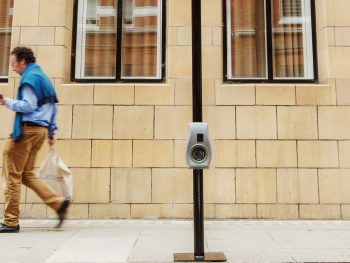Number of UK charge points needs to increase 10-fold by 2030 to cater for ICE ban
The number of charge points in the UK will need to increase 10-fold by 2030 to cater for the fast-growing number of EV drivers.

The research shows 80% of drivers need reliable, affordable charging located where their car is parked while at home to convince them to go electric
That’s according to a new report that sees industry leaders from across the finance, infrastructure, energy, local government and EV charging sectors collectively call for a fundamental “step change” in ambition of the UK’s EV charging rollout to deliver the 2030 ICE phase-out.
Published by EV charging infrastructure specialist Connected Kerb, the ‘How to meet the UK’s EV charging needs by 2030’ research includes views from experts at EY, UKPN, Motability and Mitie Group Plc.
The report outlines what national and local government, investors, developers and charging point providers must do to ensure the UK is able to deliver ubiquitous, affordable and easy-to-access charging points for all.
EV registrations are rocketing in the UK – up 154% year to date in February 2022 compared to 2021 – and are forecast to outstrip diesel and hybrid sales by the end of 2022.
But the growth in public EV charging isn’t keeping pace and the ratio of EV charge points to plug-in cars deteriorated by 31% during 2020 alone.
Britain’s current 16:1 ratio is flagging far behind other countries including South Korea (3:1), the Netherlands (5:1), France (10:1), Belgium and Japan (both 13:1).
“Solving the EV charging challenge is absolutely fundamental to achieving a cleaner, and fairer transport future,” said Chris Pateman-Jones, CEO of Connected Kerb.
“There is an opportunity ahead of us to make a real and positive impact, reducing UK transport emissions, whilst positioning the UK as a world leader on EVs. Our report highlights the need for a collaborative approach between different stakeholders within the industry and identifies a roadmap to ensure the UK’s charging infrastructure is fit for purpose, ready to unlock a future of zero-emission transport.”
While rapid and ultra-rapid charging is developing well in public spaces such as car parks and motorway service stations, driver demand for affordable and easy-to-access on-street charging is not being met – 80% of respondents in the research for the report said that reliable and affordable chargers located where their car is parked while at home is “essential” or “very important” to their decision on switching to an EV.
To tackle this, the report identifies five key areas of action:
“Think big”: Ambitions must be stepped up on EV charging deployment to install thousands of chargers, not tens. This is particularly targeted at local authorities.
Understand demand: An evidence-based approach should be used to determine the size of user base and dwell time and forecast how this will change over time. If most parking is overnight or all day, many 7kW long dwell chargers may be better than a few expensive rapid chargers. If it is mixed-use, multiple options may be needed.
Longer-term financing: Focusing on future-proofed, long-life durable chargers will unlock long-term contracts. Five-year contracts will attract short-term finance looking for fast returns, limiting deployment of chargers to areas of high early EV uptake. 20-year contracts will attract patient infrastructure capital willing to forgo profits for 10+ years. This unlocks low capital costs and enables large scale rapid deployment now, ahead of growing demand.
Install ahead of demand: Anticipating how EV use will grow and installing the ‘behind-the-scenes’ ground infrastructure from the start, such as grid connections and passive ducting, enables more flexible expansion once EV uptake increases – charging sockets can simply be added later, saving money and time.
Inclusivity: There will be 2.7 million UK drivers or passengers with a disability by 2035. This group disproportionately lives in homes without private parking and is less likely to switch to EVs without very reliable access to charging. All parties must provide sufficient charging that is designed to be inclusive of drivers with disabilities.
Education and engagement: Lack of understanding about the benefits of EVs remains a key barrier to EV adoption. Focusing on centralised education programmes and community engagement on the benefits of driving electric can drive forward the transition.
Chris Pateman-Jones, CEO of Connected Kerb, said: “The industry is migrating from early adopters, tolerant of patchy performance, to a mass market of mainstream drivers that rightly expect consistent high performance. This demands a radical change of mindset amongst national and local government, investors, developers, and charging point providers. Connected Kerb is leading the charge with mass deployment of EV charging infrastructure. We believe this report will help galvanise action across the industry to deliver a comprehensive and equitable EV transition.”












